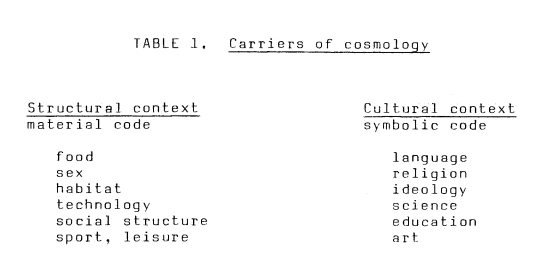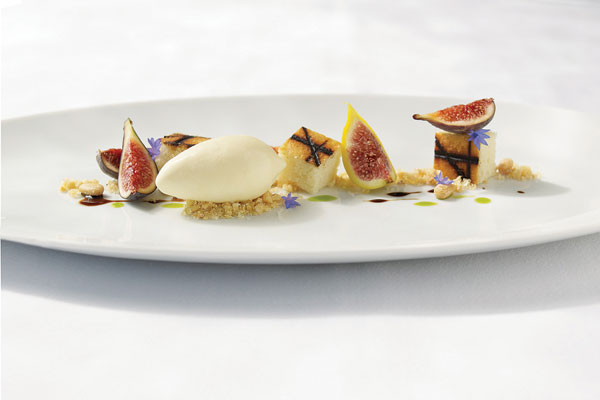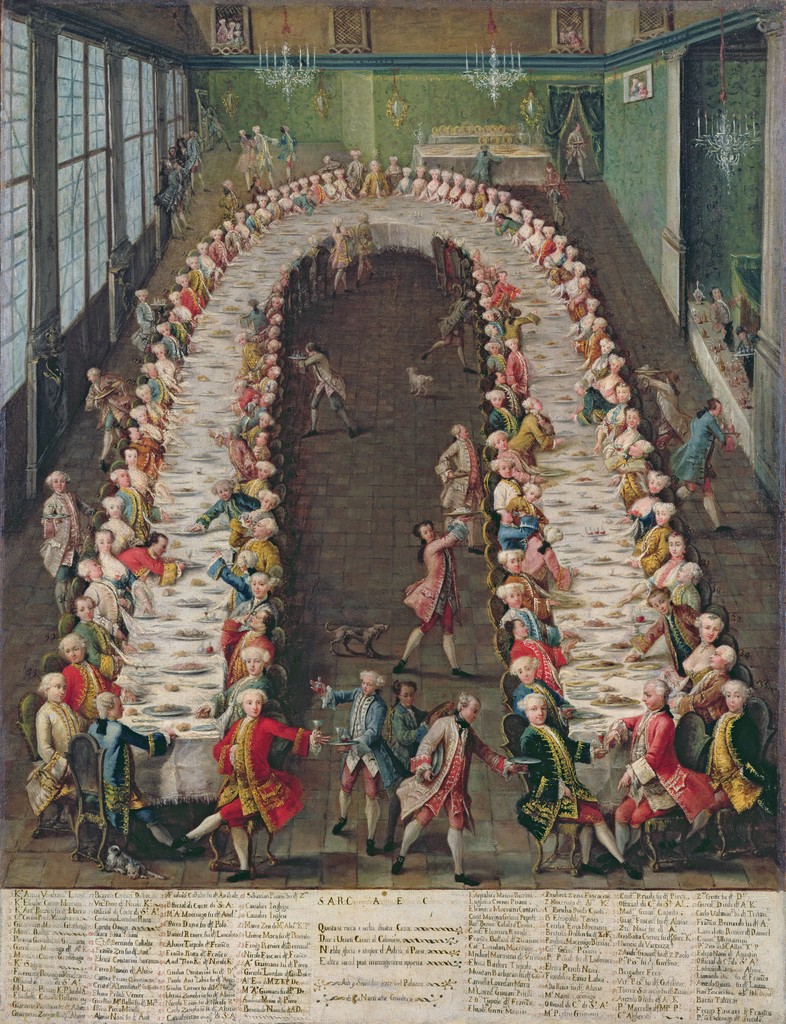I was recently approached on Twitter by Johan Galtung, the legendary scholar of peace studies and the creator of many ideas used by practitioners and students of peace and conflict: structural violence, negative vs. positive peace, and the whole concept of peacebuilding originated with him. He holds nine honorary doctorates and won the Right Livelihood Award, an “Alternative Nobel Prize.” I studied his work in depth during my Master’s program and wrote many essays based entirely on his work. To say I was shocked (and pleased) to see his comments directed at my feed would be an understatement.


What Dr. Galtung was tweeting to me about, though, was not truly conflict resolution or peacebuilding but food, and food’s role in culture. Also, the role of sexuality as an indicator of civilization. I won’t get too much into the latter, but I understand why he sent me his piece “Civilization, Time, Sexual Rhythms and Conflict” from 1997 – we’ll get to that later.
 So, Dr. Galtung, some feedback.
So, Dr. Galtung, some feedback.
In your 1986 piece “Carriers of Cosmology” you analyzed the idea of ‘Cosmology’ as “the code of a civilization,” where civilization can be in turn described as a “macro-culture,” one that spans nations and generations. Therefore, a cosmology is the code – the underlying language – that, when taken in its entirety describes the entirety of a cross-generational, multinational culture. You make many interesting points throughout the piece, about how a civilization can survive its own inhabitants and how a civilization’s code is learned, not innate. In this piece, I will need to focus a bit more narrowly (so that I’m not in over my head) on a few of your points about food; after all, this is a blog on food and diplomacy, and I shouldn’t attempt to enter into the deep end of sociological analysis!
So on to food, and maybe a bit of sex.
I agree wholeheartedly that food is a cosmological carrier; that is, it is one of the pieces of a civilization’s code that is programmed into each of us as we enter into our respective cultures. This has been shown by many people smarter than myself: food is culture. Brillat-Savarin’s famous phrase underlines this: “Tell me what you eat, and I’ll tell you what you are.” You state that food is the most basic carrier of cosmology in a structural – not cultural – context. This is due to its importance as a basic human need – we need to eat to survive. You connect the foundational significance of food in a structural context to language in a cultural one — each is given to an individual from the first moments of life. This is fascinating: both food and language are building blocks of civilization and are learned by each of us from birth.

I may push back a little here and say that food, while a basic human need, also resides further down on both the structural and cultural lists: food as leisure, food as art. We find ourselves in a moment in which chefs are rock stars, chefs are gladiators, chefs are entertainers. We watch cooking shows as pornography, as competition, as comfort. Chefs themselves are creating finer and finer pieces on the plate and charging extravagant sums for the privilege of seeing them, and perhaps enjoying a bite or two (one or two bites tends to be the extent of what’s on the plate!) Gourmands worldwide debate the finesse and touch of the hand of Thomas Keller or Daniel Humm as aesthetes analyze the paint strokes of van Gogh or the harmonic structures of Beethoven.

But back to your parallel between food and language. I would jump off here and suggest that there may be a similar parallel in the structure of each. You cite Chomsky’s work on the deep grammars of language; I’ll cite Paul Prud’homme’s concept of the Holy Trinity in Cajun cooking (and I’m sure many smarter food scholars than myself have taken this on; please point me to some good research on this!) to posit that there are deep grammars of cuisine. In this case the building blocks are the ingredients in a civilization’s cooking that provide immediate signposts to its provenance. Rice, of course, is an indicator, as is the use of certain types of flour, whether corn or wheat. Then there are spices – NPR just published an interesting piece about cumin’s role throughout history and around the world, and the use of cinnamon, chili, citrus, black pepper, and others can definitively identify from which civilization a dish emerged. The Cajun Holy Trinity is onions, bell peppers, and celery, while French mirepoix replaces the bell peppers with carrots and Italian soffritto mixes onions, garlic, and tomato. These are the deep grammars of cuisine.

And now onto sex.
You got going in an interesting direction right at the end of the piece; I searched and searched for its continuation but couldn’t find anything. Maybe there’s more somewhere and I didn’t look hard enough, or perhaps you continued in your 1997 piece on sexual rhythms among various civilizations. You wrote about the difference between Western and Chinese cooking, and the idea of “climax” in Western cooking. The “classical French meal” moves from light (hors d’oeuvres and fish; white wine) to heavy (meat and red wine) before it relaxes with cheese, dessert, and coffee. It is asymmetrical, irreversible, and notably masculine. Like Western male sexuality, there is the foreplay of bubbly and nibbles, the build-up of light white wine and delicate fish, and the climax of deep, blood-red merlot and rare steak, to be concluded with a bit of sweet dessert, some coffee, and perhaps a cigar.
Unlike the classical French meal, the Chinese meal is “long lasting, many dishes with the same dishes reappearing, no clear climax, undulating, no clear order.” There is no roast, no big reveal, no apex. This, you say, is similar to Chinese sexual patterns of “lasting longer, distributing the climax over time in undulating, sinusoid patterns.” Notably feminine, of course. Now, this isn’t my territory, to be conjecturing about various civilizations’ sexual rhythms – I’m firmly outside my comfort zone. This sexuality talk borders on the edge of Orientalizing, but in terms of meal order, I think you’re on to something interesting. The classical Western meal order and the classical Chinese meal order are certainly different, and have different gustatory rhythms. While I’m not sure we can signify one as masculine and the other feminine, it would be interesting to get into a deeper analysis of how these gustatory rhythms arose, and what they indicate about their respective cultures.
Now, I’ll throw a kink into this thinking by stating that what we think of as the “classical French meal” is in fact Russian in origin, and only was introduced to France in the early 19th century. Prior to the introduction of service à la Russe into French dining habits, meals were served family style. I’d love to hear your sexual analysis of that little morsel!’

To sum, as I’ve gotten a bit longwinded. Civilizations have a deep structural identity, defined by a code – a variety of indicators or cosmological carriers. Food is, perhaps, the most basic of these carriers, introduced from conception by a mother to her child and remaining a basic human need throughout life. Its significance as a signifier of culture goes well beyond the need for calories to survive, though – food is, and has always been, an integral component of culture, from what ingredients are used to what order dishes are served to how diners are seated at the table (if there’s even a table at all). Food traditions create insiders and outsiders – us and them – and can become a precursor for conflict. As I have attempted to show in this blog and elsewhere, food can also be a powerful cross-cultural connector, a tool for diplomacy, for building peace, for resolving conflict. This work originated with you, Dr. Galtung, and for that I am forever grateful.